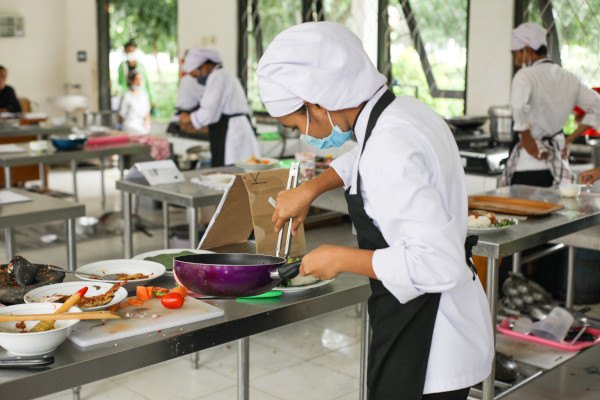How To Train Your Restaurant Employees
Although last year marked a return to financial health for many restaurants as the pandemic’s peak disruption faded, the new year bears persistent challenges and endless benefits for the food and beverage industry. As more people start to visit their favorite local restaurants, you may feel the need to add more workforce and human resources to your team to meet this growing, hungry demand.
In this article, we will share with you how to create a training program for new employees so you can help them crush their jobs and enhance their efficiency and productivity in your team.
Why Do We Train Our Employees?

May it be onboarding plans for recruits and freshly hired ones, or refresher workshops for your most loyal team players, employee training is essential to the success of any business. Not only do these programs open doors for your team to improve their skills, but also for you, as the employer, to boost employee productivity and improve overall company culture and performance.
Did you know that employees who get regular opportunities to learn, develop, and advance their skills and expertise are likely to stay loyal to a company? Bob Nelson, author of 1,001 Ways to Engage Employees, states that learning and development are some of the most prevalent factors in employee engagement.
What is Employee Training and Development?
Employee training and development program refers to the continuous effort to strengthen work performance through varying approaches like training sessions, coaching, and leadership mentoring. Training sessions are typically done for new or newly promoted employees to teach them new information or skills. On the other hand, coaching and leadership mentoring can also be provided to employees who have been working with you for quite some time but might need a refresher on performing the job better.
Training and development programs help employees manage tasks individually or as a team, as they acquire a better understanding of the processes and clearly defined goals. With this, they will spend less time and effort on a task. You can also educate your team on new skills they want to learn and improve. The more you train your small team, the more confidence you instill in each member,
Mandatory Restaurant Staff Training

Food safety training
There are many training programs for both front and back-of-house staff that focus on the basics in a restaurant: food safety, food handling, allergens, and more.
Check out your national restaurant association; they should have a clear set of guidelines, courses, and certifications for food handlers, managers, and servers. It’s crucial that your team knows how to handle, prepare, and store food to prevent food-borne illnesses. The last thing you'd want is a guest getting sick after dining with you.
Food safety includes the practices of proper food labeling, hygiene, additives and even pesticide residues. The training should also include education on food allergens. You can find the regulatory requirements for your area.
Alcohol serving and selling certifications
Some areas or regions require a license before a business can sell or serve alcohol. Alcohol safety is essential, so all your bartenders, barbacks, and servers have their alcohol certification. In addition, remember to keep an eye out for license expirations and renewals.
Workplace harassment training
Sexual harassment prevention training should be a requirement for every business. As more and more resources are shedding light on this issue, it’s becoming more common, especially in the restaurant industry, where there are incidents of harassment.
As a small business owner, you should protect your workers from sexual harassment and establish preventive measures, including mandatory sexual harassment prevention training and workplace policy requirements for employers.
You can start this by researching and staying informed about your country’s laws and requirements. If your team feels — and is — safe in the workplace, you create a happy work environment for everyone.
Server Skills Training

Menu updates
Your servers are on the front line with your customers, answering daily questions about dishes. They need to know whenever there’s a change in your restaurant’s menu — whether to a price, an item, or even an ingredient in a recipe. It's good to have trainings on how to answer any allergies or dietary restrictions questions.
Keep the team in the know on menu updates, and train and test them on them. It’ll help you make sure they’re retaining the information.
Steps of service
Your restaurant should establish your steps of service. From greeting guests, taking drink orders, sharing specials and recommendations, taking food orders, delivering the food, checking back in, clearing the table, and finally, dropping the bill. Whatever your steps are, train your staff, so they know exactly what to do.
Shadowing
Do you know what's a great way to get a new server up to speed? Shadowing. To do this, the new employee follows along with a fellow employee in their daily activities. They get one-on-one training with an experienced employee and a firsthand look at how to execute things. Shadowing will help bring the ideas they’ve heard and read about to life. Please encourage them to ask questions to the server they’re shadowing along the way.
Just make sure the employee that the new team member will be shadowing is ready to be a guide and mentor for the day, not someone who isn’t particularly willing to help or particularly friendly.
Back-of-House Training

Shadowing
Up close and personal training with fellow cooks on the line can help new cooks understand just how each dish is made. You can also have your cooks shadow your servers and vice versa so they can better understand the entire guest experience.
Cook training
Different stations in the kitchen have different rules, and all employees must be aware of the various nuances. The new chef can start by doing prep, keeping the station clean, and cooking sides. After a few days, the cook can swap places with the new person, so the new cook is cooking the main dishes as the existing one is watching. After weeks of this, the new cook should be able to run the station alone without a problem.
Kitchen Safety
Chefs and other staff members should learn the basics regarding your kitchen’s safety. A refresher never hurts, even if they’ve been working with you for a while.
Kitchen safety tips include washing hands after handling raw meat, poultry, or seafood, keeping perishable foods in refrigerators, and keeping cooked food away from cutting boards with raw meat on them.
Every crew member should also learn the basics of extinguishing a fire, proper knife skills, and how to treat burns.
Engaging Restaurant Training Strategies

Of course, your restaurant workers want to learn, but it’s getting harder to catch their attention. It’s not because they are lazy or unmotivated; we are at a time of rapidly evolving technology, and learning styles have definitely evolved.
Your employee training has to be designed to capture attention and be engaging so that they can absorb the information better.
Here are a few training strategies you can use to engage new employees:
Video Learning
YouTube is home to millions of short, instructional videos that can help new employees pick up new knowledge at their own pace. Video learning strategies alongside in-person training is a great way to mix up your training formats and keep your team engaged. You can also create your own training videos if you have the resources.
Peer-to-Peer Mentoring
You can have your old employees act as mentors to new employees. Learning from people on the same level as your staff has its own value. Being paired with a coworker makes new employees feel more comfortable and can create a culture of positive feedback.
Gamification
Whether making team competitions or daily leaderboards based on quiz outcomes or training progress, gamifying your employee training increases knowledge retention. It also motivates your staff, both new and existing employees. You can also apply the gamified experience to a sales competition to see who can sell the most specials. Use an employee productivity tracker to monitor this. It can be an easy and fun way to make work more enjoyable while boosting motivation..
Team Building
Team building and work friendships increase employee satisfaction. Research has found that people with strong work relationships are more engaged, produce higher-quality work, and have higher well-being overall. Enjoy some icebreakers, and make opportunities for socializing, like team dinners, trips to the movies, or physical activities like a team running group. Running a restaurant business is stressful, so anything you can do to help your team see it as a fun and friendly job will get them to stick around and stay motivated.
Training Staff on New Restaurant Technology

As businesses adapt to the rapidly changing world, they must implement new technologies. But when rolling out technology in your business, your staff must know how to use the technology effectively.
Businesses of all kinds, especially restaurant businesses, are now operating in a time when having a strong automated and intuitive infrastructure is essential to achieve success with better efficiency and productivity.
When deploying new technology, leaders may have insight into what is required from a technological and business standpoint; however, they need to ensure that these changes are embraced by their workforce.
Easy To Use Restaurant POS
The world of running restaurants has been made so much easier and more convenient thanks to automation tools such as Restaurant POS, Kitchen Display Systems, Customer Display Systems, Inventory Management, and Employee Management Tools. This is why it's important for your food business to have intuitive and easy to use technology so everyone on board can make the most of the benefits of automating the most fundamental processes of running a restaurant.
Having a smart and effective Restaurant POS can help you boost productivity so that your staff can reduce the time, money, and resources needed to rectify mistakes. When employees are knowledgeable about the applications they use, they can work more effectively and finish projects faster.
Training and upskilling employees from a technology perspective will help them harness the power of innovation to drive your business forward – and eventually improve the customer experience.
Businesses that understand how to use their solutions effectively are likelier to outperform those that struggle to grasp the basics – enabling them to gain a competitive advantage.
Conclusion
Implementing an effective employee development program will increase the competency of your staff and boost their job satisfaction. Not only will your workforce benefit, but your customers too, increasing the chances of repeat customers and of course, word-of-mouth referrals- the most powerful marketing strategy of all. Creating a training program for employees is truly a win-win.
Technology is not only essential for day-to-day business practices; it can also help businesses to change how they operate and grow. Successful restaurants don’t view technology only as a means to automate processes; they recognize its value and potential as a whole . Therefore, savvy decision-makers understand the importance of training employees well to leverage and utilize new technology.
-
 2
2



0 Comments
Recommended Comments
There are no comments to display.
Please sign in to comment
You will be able to leave a comment after signing in
Sign In Now